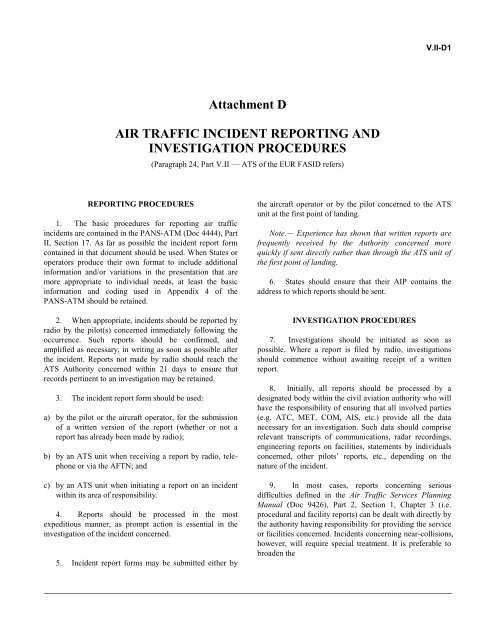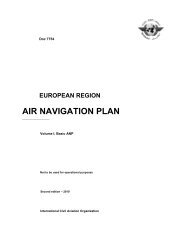7754 Vol 2 Flyleaf - ICAO Public Maps
7754 Vol 2 Flyleaf - ICAO Public Maps
7754 Vol 2 Flyleaf - ICAO Public Maps
You also want an ePaper? Increase the reach of your titles
YUMPU automatically turns print PDFs into web optimized ePapers that Google loves.
V.II-D1<br />
Attachment D<br />
AIR TRAFFIC INCIDENT REPORTING AND<br />
INVESTIGATION PROCEDURES<br />
(Paragraph 24, Part V.II — ATS of the EUR FASID refers)<br />
REPORTING PROCEDURES<br />
1. The basic procedures for reporting air traffic<br />
incidents are contained in the PANS-ATM (Doc 4444), Part<br />
II, Section 17. As far as possible the incident report form<br />
contained in that document should be used. When States or<br />
operators produce their own format to include additional<br />
information and/or variations in the presentation that are<br />
more appropriate to individual needs, at least the basic<br />
information and coding used in Appendix 4 of the<br />
PANS-ATM should be retained.<br />
2. When appropriate, incidents should be reported by<br />
radio by the pilot(s) concerned immediately following the<br />
occurrence. Such reports should be confirmed, and<br />
amplified as necessary, in writing as soon as possible after<br />
the incident. Reports not made by radio should reach the<br />
ATS Authority concerned within 21 days to ensure that<br />
records pertinent to an investigation may be retained.<br />
3. The incident report form should be used:<br />
a) by the pilot or the aircraft operator, for the submission<br />
of a written version of the report (whether or not a<br />
report has already been made by radio);<br />
b) by an ATS unit when receiving a report by radio, telephone<br />
or via the AFTN; and<br />
c) by an ATS unit when initiating a report on an incident<br />
within its area of responsibility.<br />
4. Reports should be processed in the most<br />
expeditious manner, as prompt action is essential in the<br />
investigation of the incident concerned.<br />
5. Incident report forms may be submitted either by<br />
the aircraft operator or by the pilot concerned to the ATS<br />
unit at the first point of landing.<br />
Note.— Experience has shown that written reports are<br />
frequently received by the Authority concerned more<br />
quickly if sent directly rather than through the ATS unit of<br />
the first point of landing.<br />
6. States should ensure that their AIP contains the<br />
address to which reports should be sent.<br />
INVESTIGATION PROCEDURES<br />
7. Investigations should be initiated as soon as<br />
possible. Where a report is filed by radio, investigations<br />
should commence without awaiting receipt of a written<br />
report.<br />
8. Initially, all reports should be processed by a<br />
designated body within the civil aviation authority who will<br />
have the responsibility of ensuring that all involved parties<br />
(e.g. ATC, MET, COM, AIS, etc.) provide all the data<br />
necessary for an investigation. Such data should comprise<br />
relevant transcripts of communications, radar recordings,<br />
engineering reports on facilities, statements by individuals<br />
concerned, other pilots’ reports, etc., depending on the<br />
nature of the incident.<br />
9. In most cases, reports concerning serious<br />
difficulties defined in the Air Traffic Services Planning<br />
Manual (Doc 9426), Part 2, Section 1, Chapter 3 (i.e.<br />
procedural and facility reports) can be dealt with directly by<br />
the authority having responsibility for providing the service<br />
or facilities concerned. Incidents concerning near-collisions,<br />
however, will require special treatment. It is preferable to<br />
broaden the














